Leadership and Change: Analysis of Care UK's Change Program
VerifiedAdded on 2023/06/03
|16
|4483
|229
Report
AI Summary
This report provides a comprehensive analysis of the change program implemented at Care UK, a major healthcare provider in the UK. The report begins by introducing the importance of change management in enhancing organizational performance and creating a conducive environment for growth, highlighting the challenges faced by Care UK and the need for effective mitigation strategies. It outlines the key phases of change management, including creating urgency, forming a change team, developing a vision, communicating the program, and cultivating a change culture. The report then delves into the company's life cycle using Greiner's model, discussing the stages of growth and the current position of Care UK. Furthermore, it applies Fielder's Contingency Theory to analyze situational variables at Care UK using the 5C method, examining the company's internal and external environments with factors such as company capabilities, competitors, customers, and collaborators. The report explores the impact of these variables on the change program, particularly emphasizing the competitive healthcare market and the evolving needs of patients, and how these factors influence the overall success of the change initiative. The report also discusses the leadership approaches employed by the management to deal with transitions arising from the implementation of the change program, and how these approaches align with the theories and models mentioned throughout the analysis.
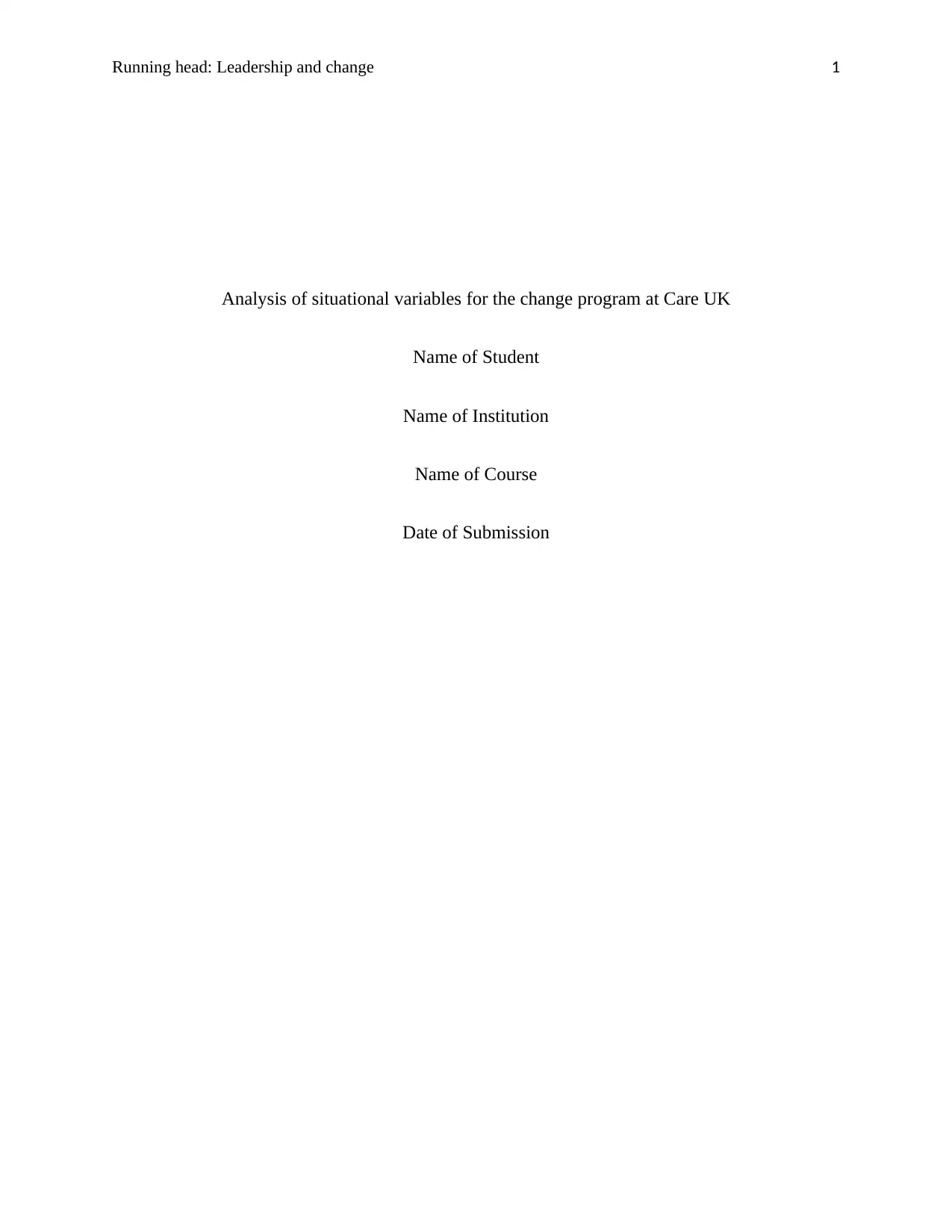
Running head: Leadership and change 1
Analysis of situational variables for the change program at Care UK
Name of Student
Name of Institution
Name of Course
Date of Submission
Analysis of situational variables for the change program at Care UK
Name of Student
Name of Institution
Name of Course
Date of Submission
Paraphrase This Document
Need a fresh take? Get an instant paraphrase of this document with our AI Paraphraser
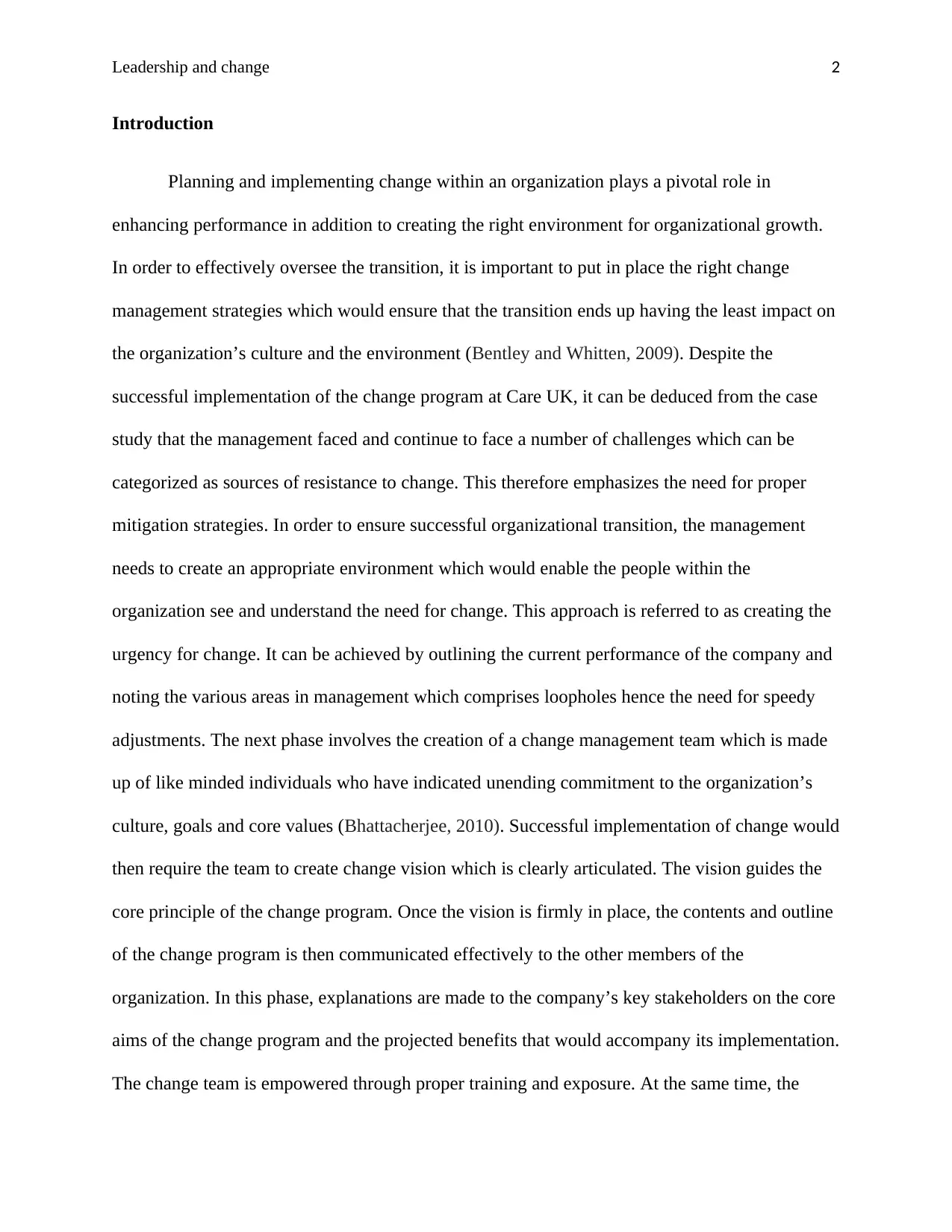
Leadership and change 2
Introduction
Planning and implementing change within an organization plays a pivotal role in
enhancing performance in addition to creating the right environment for organizational growth.
In order to effectively oversee the transition, it is important to put in place the right change
management strategies which would ensure that the transition ends up having the least impact on
the organization’s culture and the environment (Bentley and Whitten, 2009). Despite the
successful implementation of the change program at Care UK, it can be deduced from the case
study that the management faced and continue to face a number of challenges which can be
categorized as sources of resistance to change. This therefore emphasizes the need for proper
mitigation strategies. In order to ensure successful organizational transition, the management
needs to create an appropriate environment which would enable the people within the
organization see and understand the need for change. This approach is referred to as creating the
urgency for change. It can be achieved by outlining the current performance of the company and
noting the various areas in management which comprises loopholes hence the need for speedy
adjustments. The next phase involves the creation of a change management team which is made
up of like minded individuals who have indicated unending commitment to the organization’s
culture, goals and core values (Bhattacherjee, 2010). Successful implementation of change would
then require the team to create change vision which is clearly articulated. The vision guides the
core principle of the change program. Once the vision is firmly in place, the contents and outline
of the change program is then communicated effectively to the other members of the
organization. In this phase, explanations are made to the company’s key stakeholders on the core
aims of the change program and the projected benefits that would accompany its implementation.
The change team is empowered through proper training and exposure. At the same time, the
Introduction
Planning and implementing change within an organization plays a pivotal role in
enhancing performance in addition to creating the right environment for organizational growth.
In order to effectively oversee the transition, it is important to put in place the right change
management strategies which would ensure that the transition ends up having the least impact on
the organization’s culture and the environment (Bentley and Whitten, 2009). Despite the
successful implementation of the change program at Care UK, it can be deduced from the case
study that the management faced and continue to face a number of challenges which can be
categorized as sources of resistance to change. This therefore emphasizes the need for proper
mitigation strategies. In order to ensure successful organizational transition, the management
needs to create an appropriate environment which would enable the people within the
organization see and understand the need for change. This approach is referred to as creating the
urgency for change. It can be achieved by outlining the current performance of the company and
noting the various areas in management which comprises loopholes hence the need for speedy
adjustments. The next phase involves the creation of a change management team which is made
up of like minded individuals who have indicated unending commitment to the organization’s
culture, goals and core values (Bhattacherjee, 2010). Successful implementation of change would
then require the team to create change vision which is clearly articulated. The vision guides the
core principle of the change program. Once the vision is firmly in place, the contents and outline
of the change program is then communicated effectively to the other members of the
organization. In this phase, explanations are made to the company’s key stakeholders on the core
aims of the change program and the projected benefits that would accompany its implementation.
The change team is empowered through proper training and exposure. At the same time, the
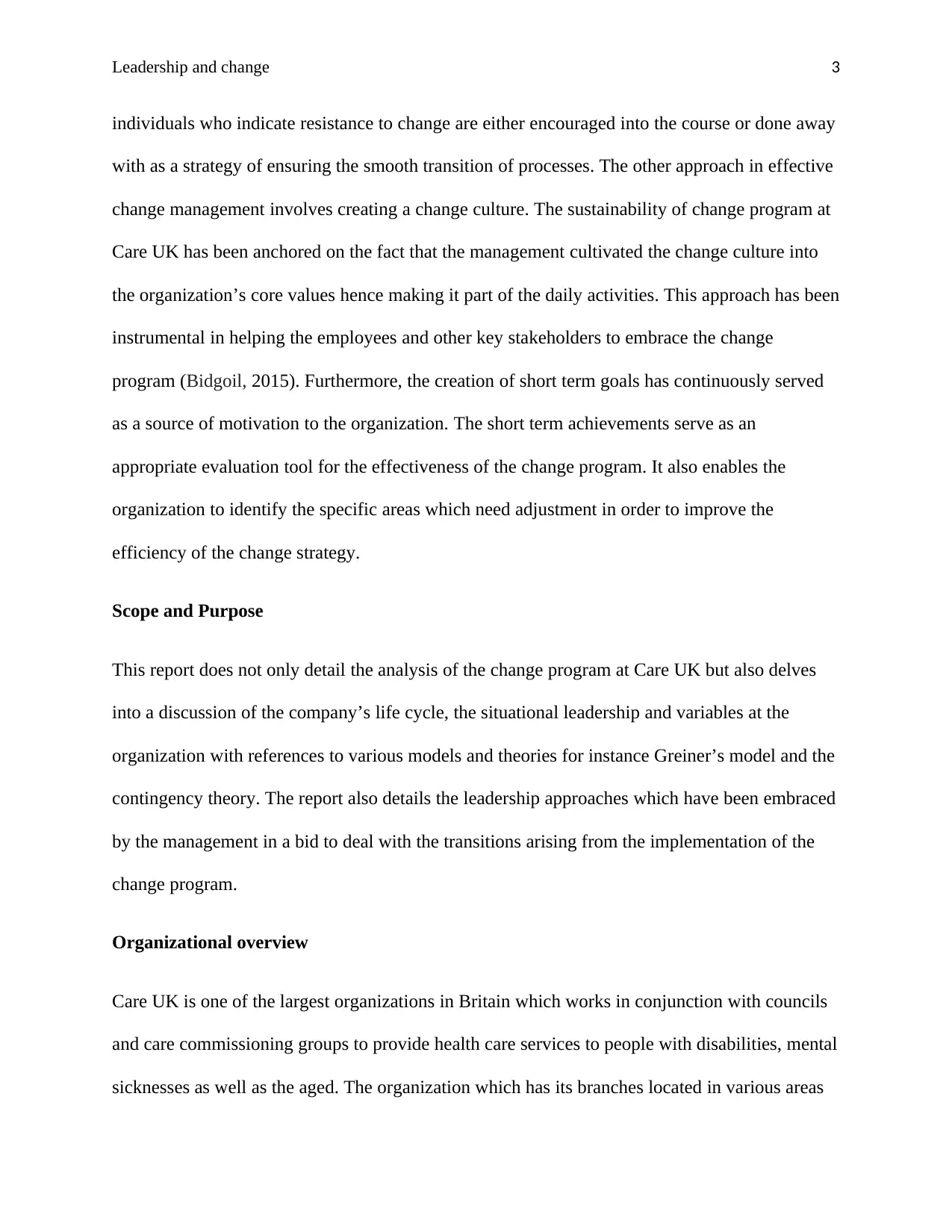
Leadership and change 3
individuals who indicate resistance to change are either encouraged into the course or done away
with as a strategy of ensuring the smooth transition of processes. The other approach in effective
change management involves creating a change culture. The sustainability of change program at
Care UK has been anchored on the fact that the management cultivated the change culture into
the organization’s core values hence making it part of the daily activities. This approach has been
instrumental in helping the employees and other key stakeholders to embrace the change
program (Bidgoil, 2015). Furthermore, the creation of short term goals has continuously served
as a source of motivation to the organization. The short term achievements serve as an
appropriate evaluation tool for the effectiveness of the change program. It also enables the
organization to identify the specific areas which need adjustment in order to improve the
efficiency of the change strategy.
Scope and Purpose
This report does not only detail the analysis of the change program at Care UK but also delves
into a discussion of the company’s life cycle, the situational leadership and variables at the
organization with references to various models and theories for instance Greiner’s model and the
contingency theory. The report also details the leadership approaches which have been embraced
by the management in a bid to deal with the transitions arising from the implementation of the
change program.
Organizational overview
Care UK is one of the largest organizations in Britain which works in conjunction with councils
and care commissioning groups to provide health care services to people with disabilities, mental
sicknesses as well as the aged. The organization which has its branches located in various areas
individuals who indicate resistance to change are either encouraged into the course or done away
with as a strategy of ensuring the smooth transition of processes. The other approach in effective
change management involves creating a change culture. The sustainability of change program at
Care UK has been anchored on the fact that the management cultivated the change culture into
the organization’s core values hence making it part of the daily activities. This approach has been
instrumental in helping the employees and other key stakeholders to embrace the change
program (Bidgoil, 2015). Furthermore, the creation of short term goals has continuously served
as a source of motivation to the organization. The short term achievements serve as an
appropriate evaluation tool for the effectiveness of the change program. It also enables the
organization to identify the specific areas which need adjustment in order to improve the
efficiency of the change strategy.
Scope and Purpose
This report does not only detail the analysis of the change program at Care UK but also delves
into a discussion of the company’s life cycle, the situational leadership and variables at the
organization with references to various models and theories for instance Greiner’s model and the
contingency theory. The report also details the leadership approaches which have been embraced
by the management in a bid to deal with the transitions arising from the implementation of the
change program.
Organizational overview
Care UK is one of the largest organizations in Britain which works in conjunction with councils
and care commissioning groups to provide health care services to people with disabilities, mental
sicknesses as well as the aged. The organization which has its branches located in various areas
⊘ This is a preview!⊘
Do you want full access?
Subscribe today to unlock all pages.

Trusted by 1+ million students worldwide
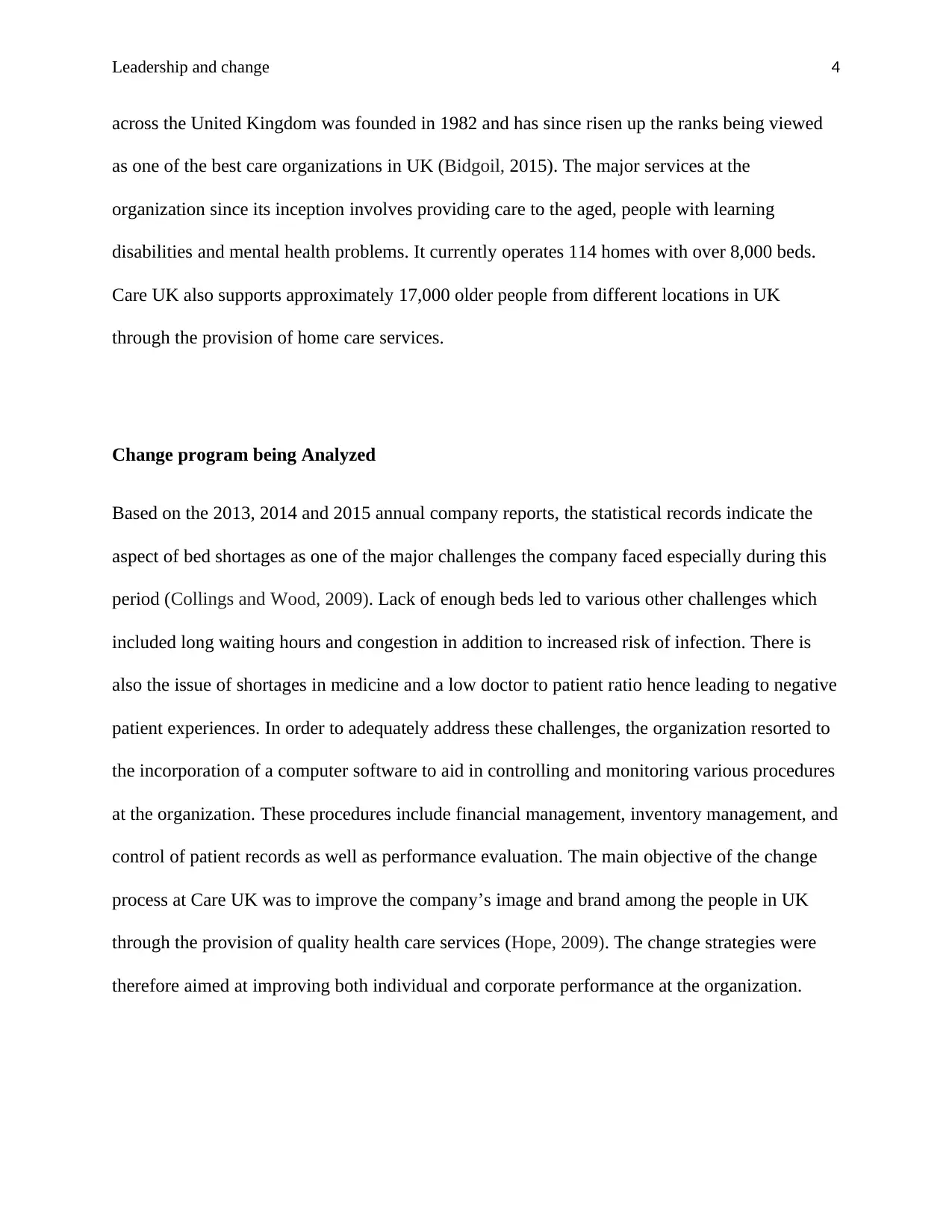
Leadership and change 4
across the United Kingdom was founded in 1982 and has since risen up the ranks being viewed
as one of the best care organizations in UK (Bidgoil, 2015). The major services at the
organization since its inception involves providing care to the aged, people with learning
disabilities and mental health problems. It currently operates 114 homes with over 8,000 beds.
Care UK also supports approximately 17,000 older people from different locations in UK
through the provision of home care services.
Change program being Analyzed
Based on the 2013, 2014 and 2015 annual company reports, the statistical records indicate the
aspect of bed shortages as one of the major challenges the company faced especially during this
period (Collings and Wood, 2009). Lack of enough beds led to various other challenges which
included long waiting hours and congestion in addition to increased risk of infection. There is
also the issue of shortages in medicine and a low doctor to patient ratio hence leading to negative
patient experiences. In order to adequately address these challenges, the organization resorted to
the incorporation of a computer software to aid in controlling and monitoring various procedures
at the organization. These procedures include financial management, inventory management, and
control of patient records as well as performance evaluation. The main objective of the change
process at Care UK was to improve the company’s image and brand among the people in UK
through the provision of quality health care services (Hope, 2009). The change strategies were
therefore aimed at improving both individual and corporate performance at the organization.
across the United Kingdom was founded in 1982 and has since risen up the ranks being viewed
as one of the best care organizations in UK (Bidgoil, 2015). The major services at the
organization since its inception involves providing care to the aged, people with learning
disabilities and mental health problems. It currently operates 114 homes with over 8,000 beds.
Care UK also supports approximately 17,000 older people from different locations in UK
through the provision of home care services.
Change program being Analyzed
Based on the 2013, 2014 and 2015 annual company reports, the statistical records indicate the
aspect of bed shortages as one of the major challenges the company faced especially during this
period (Collings and Wood, 2009). Lack of enough beds led to various other challenges which
included long waiting hours and congestion in addition to increased risk of infection. There is
also the issue of shortages in medicine and a low doctor to patient ratio hence leading to negative
patient experiences. In order to adequately address these challenges, the organization resorted to
the incorporation of a computer software to aid in controlling and monitoring various procedures
at the organization. These procedures include financial management, inventory management, and
control of patient records as well as performance evaluation. The main objective of the change
process at Care UK was to improve the company’s image and brand among the people in UK
through the provision of quality health care services (Hope, 2009). The change strategies were
therefore aimed at improving both individual and corporate performance at the organization.
Paraphrase This Document
Need a fresh take? Get an instant paraphrase of this document with our AI Paraphraser
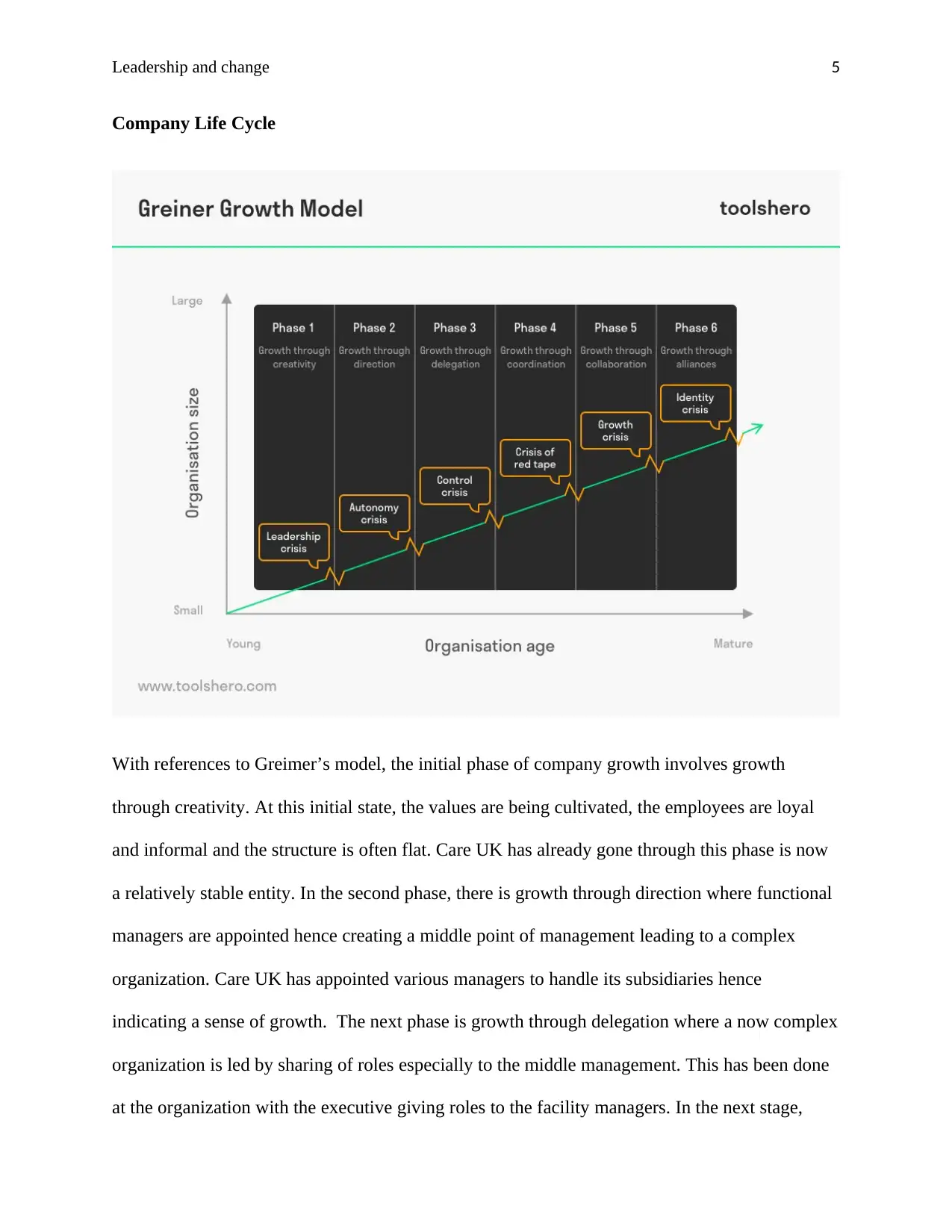
Leadership and change 5
Company Life Cycle
With references to Greimer’s model, the initial phase of company growth involves growth
through creativity. At this initial state, the values are being cultivated, the employees are loyal
and informal and the structure is often flat. Care UK has already gone through this phase is now
a relatively stable entity. In the second phase, there is growth through direction where functional
managers are appointed hence creating a middle point of management leading to a complex
organization. Care UK has appointed various managers to handle its subsidiaries hence
indicating a sense of growth. The next phase is growth through delegation where a now complex
organization is led by sharing of roles especially to the middle management. This has been done
at the organization with the executive giving roles to the facility managers. In the next stage,
Company Life Cycle
With references to Greimer’s model, the initial phase of company growth involves growth
through creativity. At this initial state, the values are being cultivated, the employees are loyal
and informal and the structure is often flat. Care UK has already gone through this phase is now
a relatively stable entity. In the second phase, there is growth through direction where functional
managers are appointed hence creating a middle point of management leading to a complex
organization. Care UK has appointed various managers to handle its subsidiaries hence
indicating a sense of growth. The next phase is growth through delegation where a now complex
organization is led by sharing of roles especially to the middle management. This has been done
at the organization with the executive giving roles to the facility managers. In the next stage,
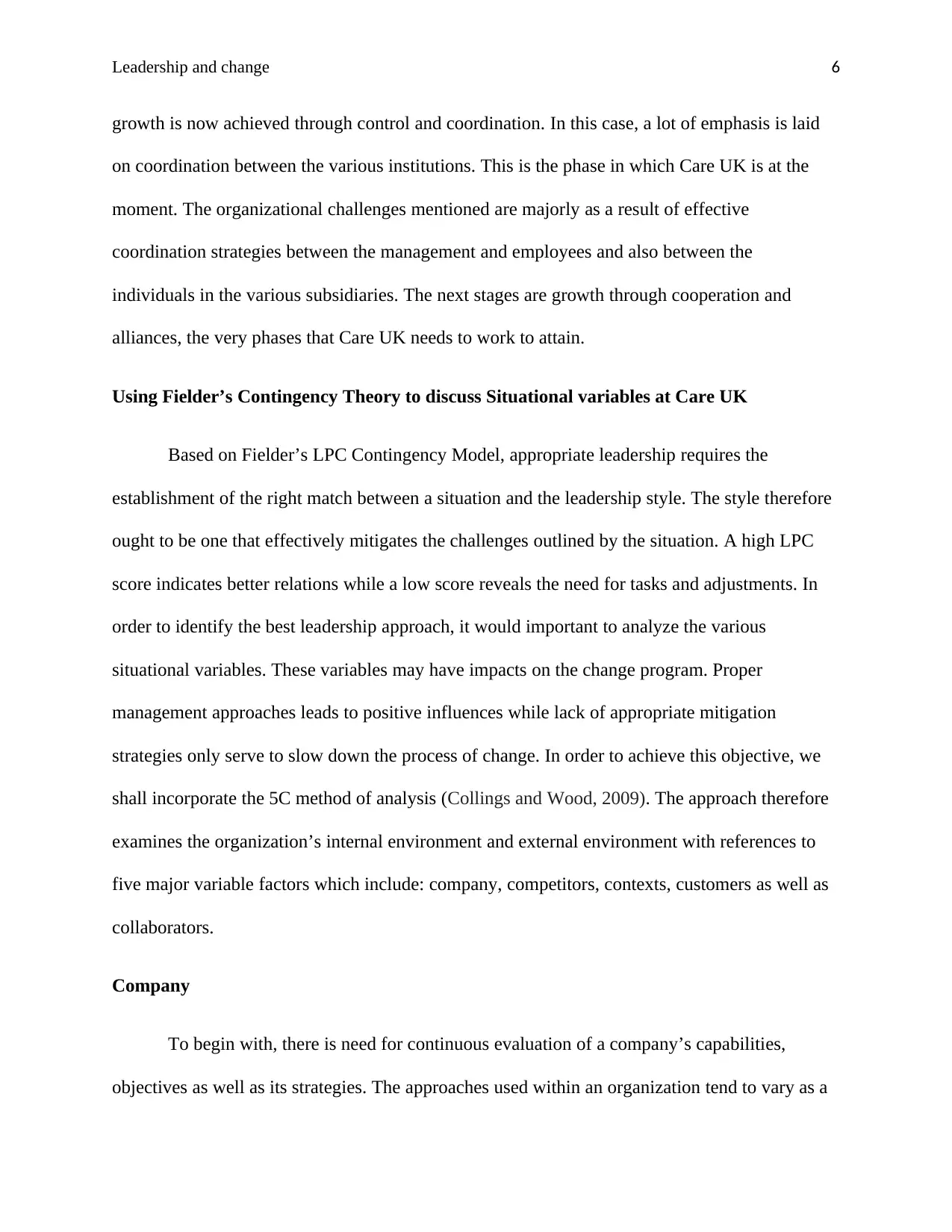
Leadership and change 6
growth is now achieved through control and coordination. In this case, a lot of emphasis is laid
on coordination between the various institutions. This is the phase in which Care UK is at the
moment. The organizational challenges mentioned are majorly as a result of effective
coordination strategies between the management and employees and also between the
individuals in the various subsidiaries. The next stages are growth through cooperation and
alliances, the very phases that Care UK needs to work to attain.
Using Fielder’s Contingency Theory to discuss Situational variables at Care UK
Based on Fielder’s LPC Contingency Model, appropriate leadership requires the
establishment of the right match between a situation and the leadership style. The style therefore
ought to be one that effectively mitigates the challenges outlined by the situation. A high LPC
score indicates better relations while a low score reveals the need for tasks and adjustments. In
order to identify the best leadership approach, it would important to analyze the various
situational variables. These variables may have impacts on the change program. Proper
management approaches leads to positive influences while lack of appropriate mitigation
strategies only serve to slow down the process of change. In order to achieve this objective, we
shall incorporate the 5C method of analysis (Collings and Wood, 2009). The approach therefore
examines the organization’s internal environment and external environment with references to
five major variable factors which include: company, competitors, contexts, customers as well as
collaborators.
Company
To begin with, there is need for continuous evaluation of a company’s capabilities,
objectives as well as its strategies. The approaches used within an organization tend to vary as a
growth is now achieved through control and coordination. In this case, a lot of emphasis is laid
on coordination between the various institutions. This is the phase in which Care UK is at the
moment. The organizational challenges mentioned are majorly as a result of effective
coordination strategies between the management and employees and also between the
individuals in the various subsidiaries. The next stages are growth through cooperation and
alliances, the very phases that Care UK needs to work to attain.
Using Fielder’s Contingency Theory to discuss Situational variables at Care UK
Based on Fielder’s LPC Contingency Model, appropriate leadership requires the
establishment of the right match between a situation and the leadership style. The style therefore
ought to be one that effectively mitigates the challenges outlined by the situation. A high LPC
score indicates better relations while a low score reveals the need for tasks and adjustments. In
order to identify the best leadership approach, it would important to analyze the various
situational variables. These variables may have impacts on the change program. Proper
management approaches leads to positive influences while lack of appropriate mitigation
strategies only serve to slow down the process of change. In order to achieve this objective, we
shall incorporate the 5C method of analysis (Collings and Wood, 2009). The approach therefore
examines the organization’s internal environment and external environment with references to
five major variable factors which include: company, competitors, contexts, customers as well as
collaborators.
Company
To begin with, there is need for continuous evaluation of a company’s capabilities,
objectives as well as its strategies. The approaches used within an organization tend to vary as a
⊘ This is a preview!⊘
Do you want full access?
Subscribe today to unlock all pages.

Trusted by 1+ million students worldwide
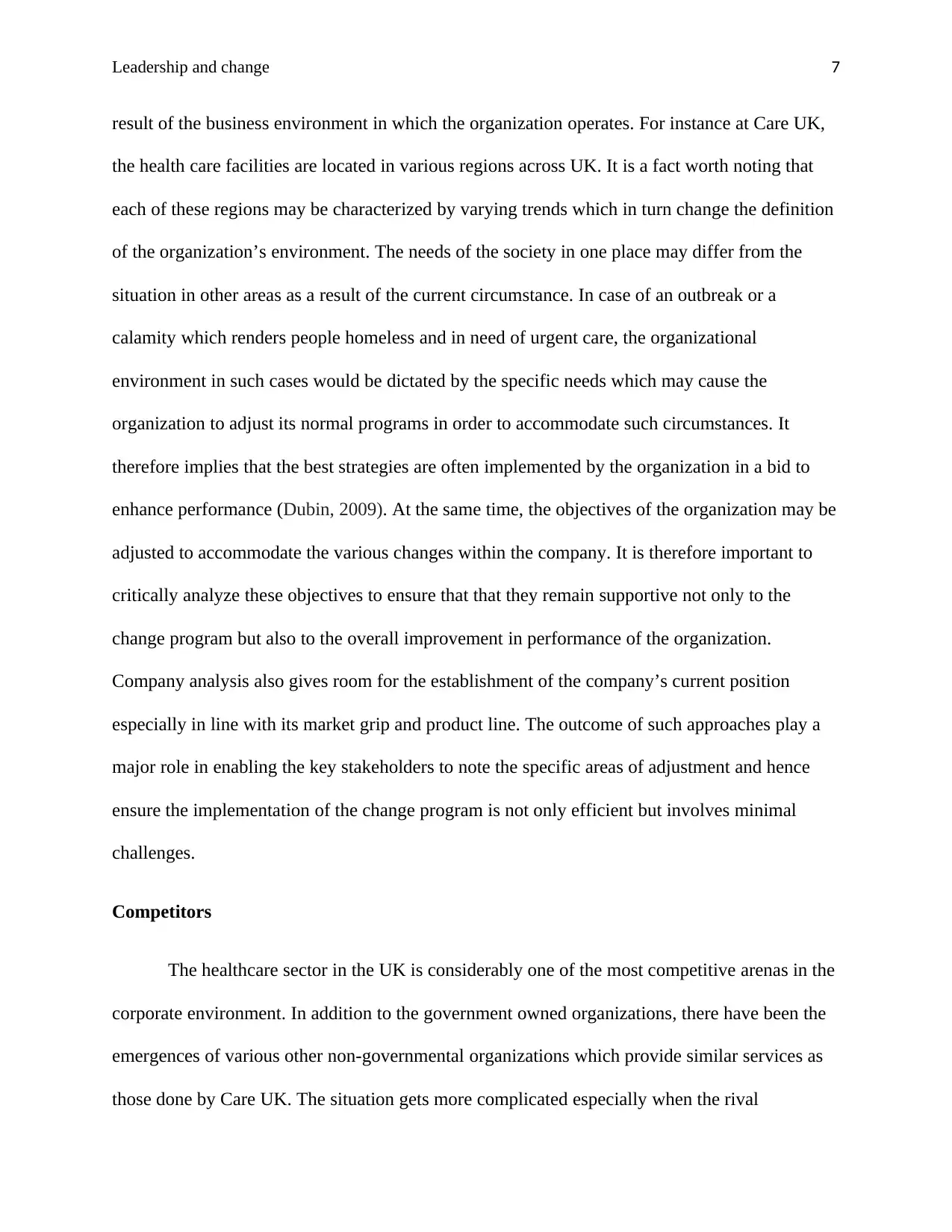
Leadership and change 7
result of the business environment in which the organization operates. For instance at Care UK,
the health care facilities are located in various regions across UK. It is a fact worth noting that
each of these regions may be characterized by varying trends which in turn change the definition
of the organization’s environment. The needs of the society in one place may differ from the
situation in other areas as a result of the current circumstance. In case of an outbreak or a
calamity which renders people homeless and in need of urgent care, the organizational
environment in such cases would be dictated by the specific needs which may cause the
organization to adjust its normal programs in order to accommodate such circumstances. It
therefore implies that the best strategies are often implemented by the organization in a bid to
enhance performance (Dubin, 2009). At the same time, the objectives of the organization may be
adjusted to accommodate the various changes within the company. It is therefore important to
critically analyze these objectives to ensure that that they remain supportive not only to the
change program but also to the overall improvement in performance of the organization.
Company analysis also gives room for the establishment of the company’s current position
especially in line with its market grip and product line. The outcome of such approaches play a
major role in enabling the key stakeholders to note the specific areas of adjustment and hence
ensure the implementation of the change program is not only efficient but involves minimal
challenges.
Competitors
The healthcare sector in the UK is considerably one of the most competitive arenas in the
corporate environment. In addition to the government owned organizations, there have been the
emergences of various other non-governmental organizations which provide similar services as
those done by Care UK. The situation gets more complicated especially when the rival
result of the business environment in which the organization operates. For instance at Care UK,
the health care facilities are located in various regions across UK. It is a fact worth noting that
each of these regions may be characterized by varying trends which in turn change the definition
of the organization’s environment. The needs of the society in one place may differ from the
situation in other areas as a result of the current circumstance. In case of an outbreak or a
calamity which renders people homeless and in need of urgent care, the organizational
environment in such cases would be dictated by the specific needs which may cause the
organization to adjust its normal programs in order to accommodate such circumstances. It
therefore implies that the best strategies are often implemented by the organization in a bid to
enhance performance (Dubin, 2009). At the same time, the objectives of the organization may be
adjusted to accommodate the various changes within the company. It is therefore important to
critically analyze these objectives to ensure that that they remain supportive not only to the
change program but also to the overall improvement in performance of the organization.
Company analysis also gives room for the establishment of the company’s current position
especially in line with its market grip and product line. The outcome of such approaches play a
major role in enabling the key stakeholders to note the specific areas of adjustment and hence
ensure the implementation of the change program is not only efficient but involves minimal
challenges.
Competitors
The healthcare sector in the UK is considerably one of the most competitive arenas in the
corporate environment. In addition to the government owned organizations, there have been the
emergences of various other non-governmental organizations which provide similar services as
those done by Care UK. The situation gets more complicated especially when the rival
Paraphrase This Document
Need a fresh take? Get an instant paraphrase of this document with our AI Paraphraser
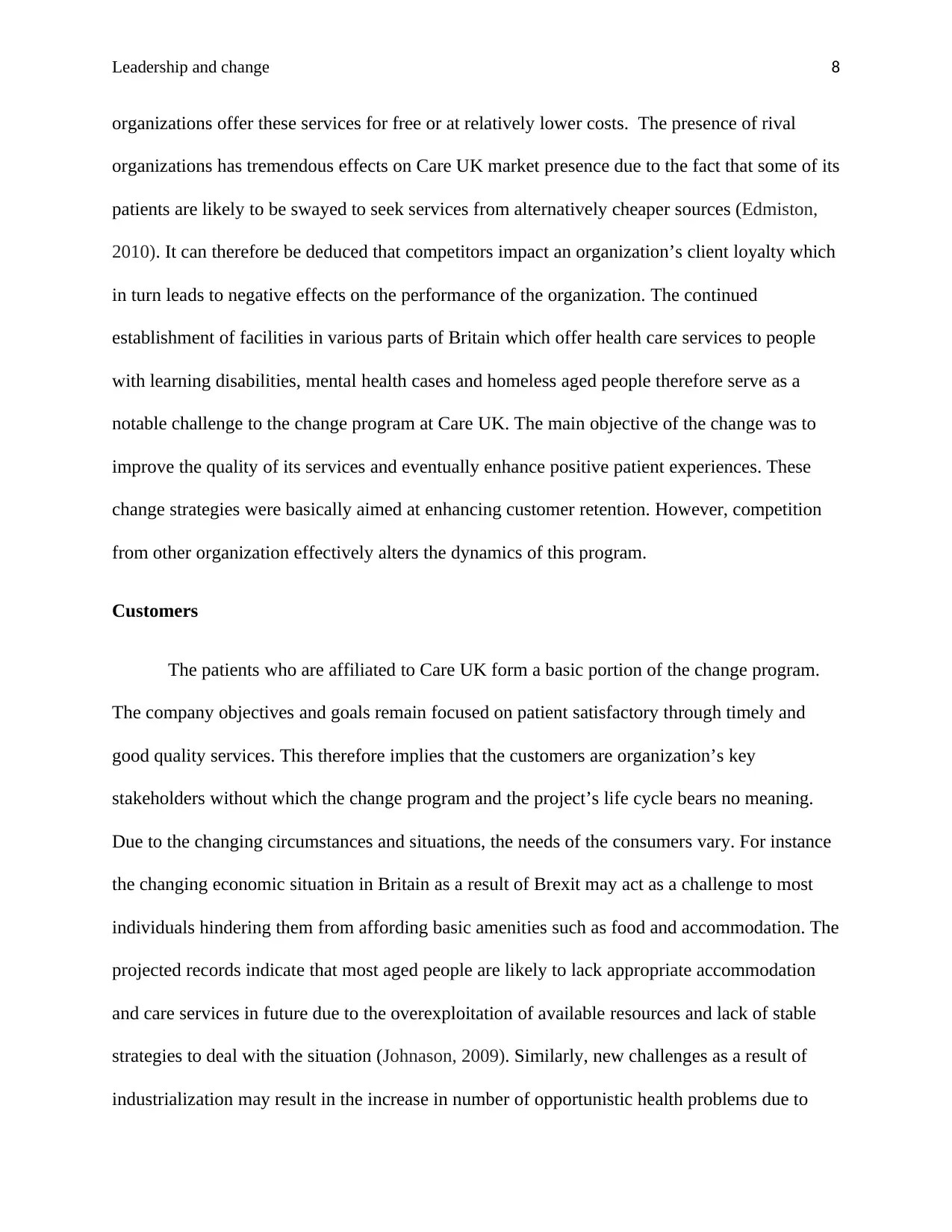
Leadership and change 8
organizations offer these services for free or at relatively lower costs. The presence of rival
organizations has tremendous effects on Care UK market presence due to the fact that some of its
patients are likely to be swayed to seek services from alternatively cheaper sources (Edmiston,
2010). It can therefore be deduced that competitors impact an organization’s client loyalty which
in turn leads to negative effects on the performance of the organization. The continued
establishment of facilities in various parts of Britain which offer health care services to people
with learning disabilities, mental health cases and homeless aged people therefore serve as a
notable challenge to the change program at Care UK. The main objective of the change was to
improve the quality of its services and eventually enhance positive patient experiences. These
change strategies were basically aimed at enhancing customer retention. However, competition
from other organization effectively alters the dynamics of this program.
Customers
The patients who are affiliated to Care UK form a basic portion of the change program.
The company objectives and goals remain focused on patient satisfactory through timely and
good quality services. This therefore implies that the customers are organization’s key
stakeholders without which the change program and the project’s life cycle bears no meaning.
Due to the changing circumstances and situations, the needs of the consumers vary. For instance
the changing economic situation in Britain as a result of Brexit may act as a challenge to most
individuals hindering them from affording basic amenities such as food and accommodation. The
projected records indicate that most aged people are likely to lack appropriate accommodation
and care services in future due to the overexploitation of available resources and lack of stable
strategies to deal with the situation (Johnason, 2009). Similarly, new challenges as a result of
industrialization may result in the increase in number of opportunistic health problems due to
organizations offer these services for free or at relatively lower costs. The presence of rival
organizations has tremendous effects on Care UK market presence due to the fact that some of its
patients are likely to be swayed to seek services from alternatively cheaper sources (Edmiston,
2010). It can therefore be deduced that competitors impact an organization’s client loyalty which
in turn leads to negative effects on the performance of the organization. The continued
establishment of facilities in various parts of Britain which offer health care services to people
with learning disabilities, mental health cases and homeless aged people therefore serve as a
notable challenge to the change program at Care UK. The main objective of the change was to
improve the quality of its services and eventually enhance positive patient experiences. These
change strategies were basically aimed at enhancing customer retention. However, competition
from other organization effectively alters the dynamics of this program.
Customers
The patients who are affiliated to Care UK form a basic portion of the change program.
The company objectives and goals remain focused on patient satisfactory through timely and
good quality services. This therefore implies that the customers are organization’s key
stakeholders without which the change program and the project’s life cycle bears no meaning.
Due to the changing circumstances and situations, the needs of the consumers vary. For instance
the changing economic situation in Britain as a result of Brexit may act as a challenge to most
individuals hindering them from affording basic amenities such as food and accommodation. The
projected records indicate that most aged people are likely to lack appropriate accommodation
and care services in future due to the overexploitation of available resources and lack of stable
strategies to deal with the situation (Johnason, 2009). Similarly, new challenges as a result of
industrialization may result in the increase in number of opportunistic health problems due to
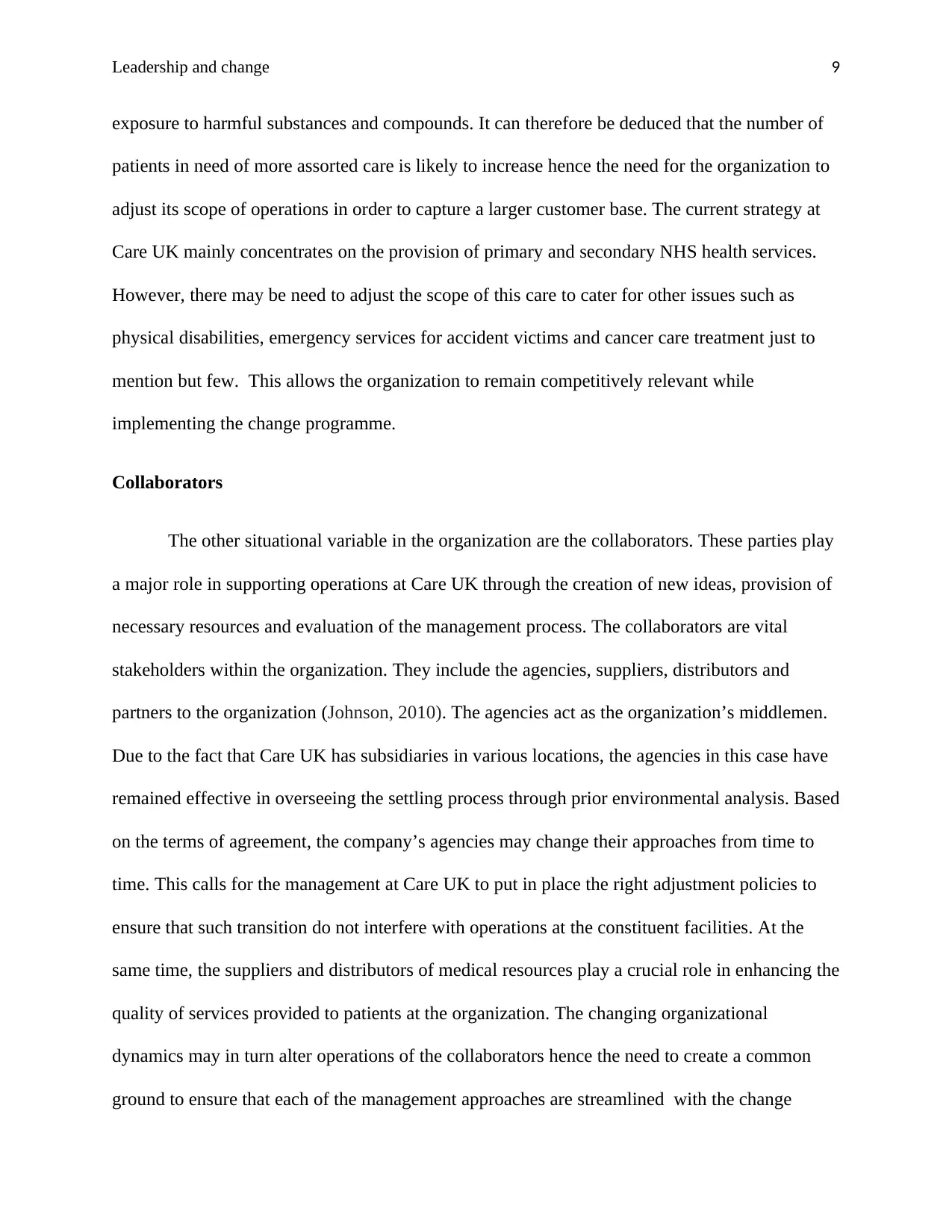
Leadership and change 9
exposure to harmful substances and compounds. It can therefore be deduced that the number of
patients in need of more assorted care is likely to increase hence the need for the organization to
adjust its scope of operations in order to capture a larger customer base. The current strategy at
Care UK mainly concentrates on the provision of primary and secondary NHS health services.
However, there may be need to adjust the scope of this care to cater for other issues such as
physical disabilities, emergency services for accident victims and cancer care treatment just to
mention but few. This allows the organization to remain competitively relevant while
implementing the change programme.
Collaborators
The other situational variable in the organization are the collaborators. These parties play
a major role in supporting operations at Care UK through the creation of new ideas, provision of
necessary resources and evaluation of the management process. The collaborators are vital
stakeholders within the organization. They include the agencies, suppliers, distributors and
partners to the organization (Johnson, 2010). The agencies act as the organization’s middlemen.
Due to the fact that Care UK has subsidiaries in various locations, the agencies in this case have
remained effective in overseeing the settling process through prior environmental analysis. Based
on the terms of agreement, the company’s agencies may change their approaches from time to
time. This calls for the management at Care UK to put in place the right adjustment policies to
ensure that such transition do not interfere with operations at the constituent facilities. At the
same time, the suppliers and distributors of medical resources play a crucial role in enhancing the
quality of services provided to patients at the organization. The changing organizational
dynamics may in turn alter operations of the collaborators hence the need to create a common
ground to ensure that each of the management approaches are streamlined with the change
exposure to harmful substances and compounds. It can therefore be deduced that the number of
patients in need of more assorted care is likely to increase hence the need for the organization to
adjust its scope of operations in order to capture a larger customer base. The current strategy at
Care UK mainly concentrates on the provision of primary and secondary NHS health services.
However, there may be need to adjust the scope of this care to cater for other issues such as
physical disabilities, emergency services for accident victims and cancer care treatment just to
mention but few. This allows the organization to remain competitively relevant while
implementing the change programme.
Collaborators
The other situational variable in the organization are the collaborators. These parties play
a major role in supporting operations at Care UK through the creation of new ideas, provision of
necessary resources and evaluation of the management process. The collaborators are vital
stakeholders within the organization. They include the agencies, suppliers, distributors and
partners to the organization (Johnson, 2010). The agencies act as the organization’s middlemen.
Due to the fact that Care UK has subsidiaries in various locations, the agencies in this case have
remained effective in overseeing the settling process through prior environmental analysis. Based
on the terms of agreement, the company’s agencies may change their approaches from time to
time. This calls for the management at Care UK to put in place the right adjustment policies to
ensure that such transition do not interfere with operations at the constituent facilities. At the
same time, the suppliers and distributors of medical resources play a crucial role in enhancing the
quality of services provided to patients at the organization. The changing organizational
dynamics may in turn alter operations of the collaborators hence the need to create a common
ground to ensure that each of the management approaches are streamlined with the change
⊘ This is a preview!⊘
Do you want full access?
Subscribe today to unlock all pages.

Trusted by 1+ million students worldwide
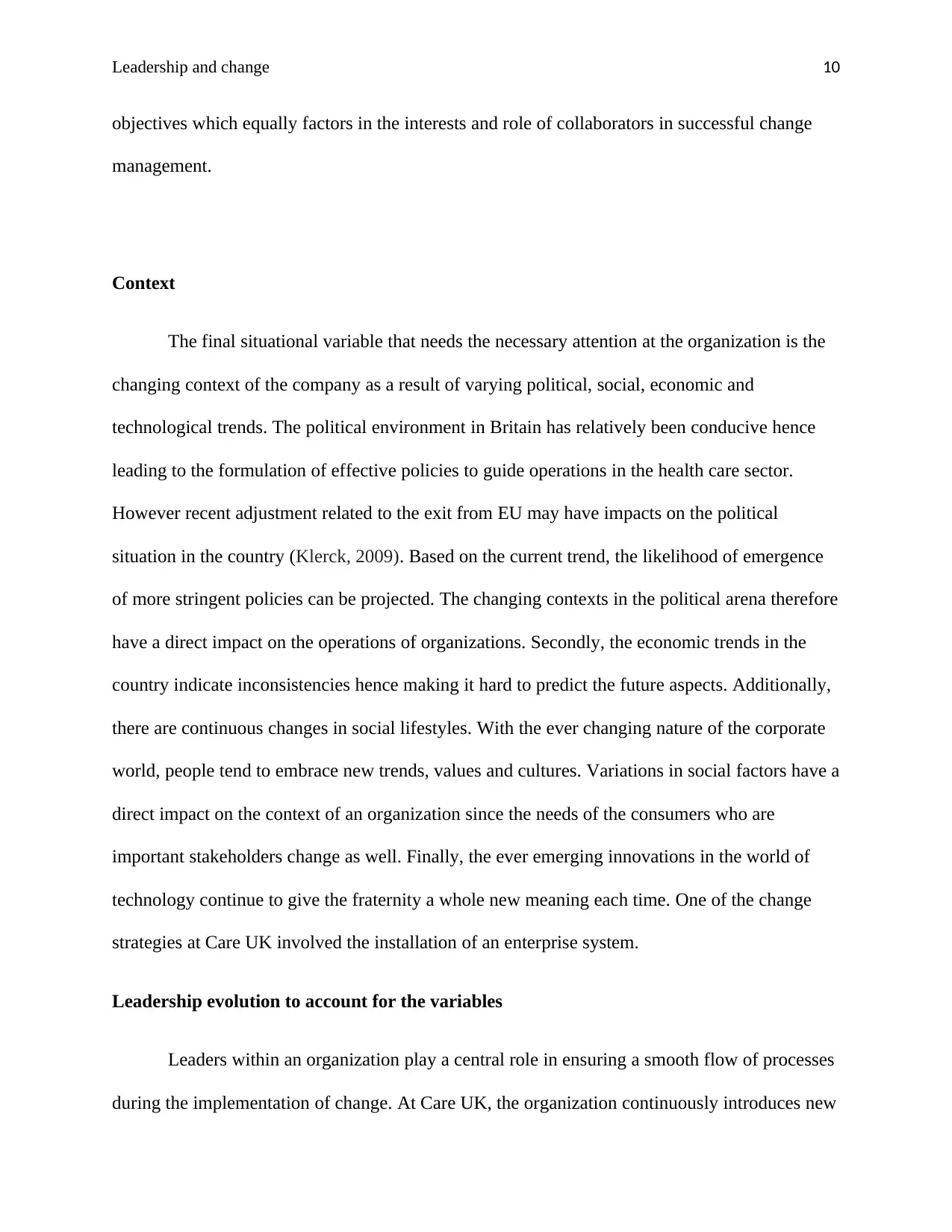
Leadership and change 10
objectives which equally factors in the interests and role of collaborators in successful change
management.
Context
The final situational variable that needs the necessary attention at the organization is the
changing context of the company as a result of varying political, social, economic and
technological trends. The political environment in Britain has relatively been conducive hence
leading to the formulation of effective policies to guide operations in the health care sector.
However recent adjustment related to the exit from EU may have impacts on the political
situation in the country (Klerck, 2009). Based on the current trend, the likelihood of emergence
of more stringent policies can be projected. The changing contexts in the political arena therefore
have a direct impact on the operations of organizations. Secondly, the economic trends in the
country indicate inconsistencies hence making it hard to predict the future aspects. Additionally,
there are continuous changes in social lifestyles. With the ever changing nature of the corporate
world, people tend to embrace new trends, values and cultures. Variations in social factors have a
direct impact on the context of an organization since the needs of the consumers who are
important stakeholders change as well. Finally, the ever emerging innovations in the world of
technology continue to give the fraternity a whole new meaning each time. One of the change
strategies at Care UK involved the installation of an enterprise system.
Leadership evolution to account for the variables
Leaders within an organization play a central role in ensuring a smooth flow of processes
during the implementation of change. At Care UK, the organization continuously introduces new
objectives which equally factors in the interests and role of collaborators in successful change
management.
Context
The final situational variable that needs the necessary attention at the organization is the
changing context of the company as a result of varying political, social, economic and
technological trends. The political environment in Britain has relatively been conducive hence
leading to the formulation of effective policies to guide operations in the health care sector.
However recent adjustment related to the exit from EU may have impacts on the political
situation in the country (Klerck, 2009). Based on the current trend, the likelihood of emergence
of more stringent policies can be projected. The changing contexts in the political arena therefore
have a direct impact on the operations of organizations. Secondly, the economic trends in the
country indicate inconsistencies hence making it hard to predict the future aspects. Additionally,
there are continuous changes in social lifestyles. With the ever changing nature of the corporate
world, people tend to embrace new trends, values and cultures. Variations in social factors have a
direct impact on the context of an organization since the needs of the consumers who are
important stakeholders change as well. Finally, the ever emerging innovations in the world of
technology continue to give the fraternity a whole new meaning each time. One of the change
strategies at Care UK involved the installation of an enterprise system.
Leadership evolution to account for the variables
Leaders within an organization play a central role in ensuring a smooth flow of processes
during the implementation of change. At Care UK, the organization continuously introduces new
Paraphrase This Document
Need a fresh take? Get an instant paraphrase of this document with our AI Paraphraser
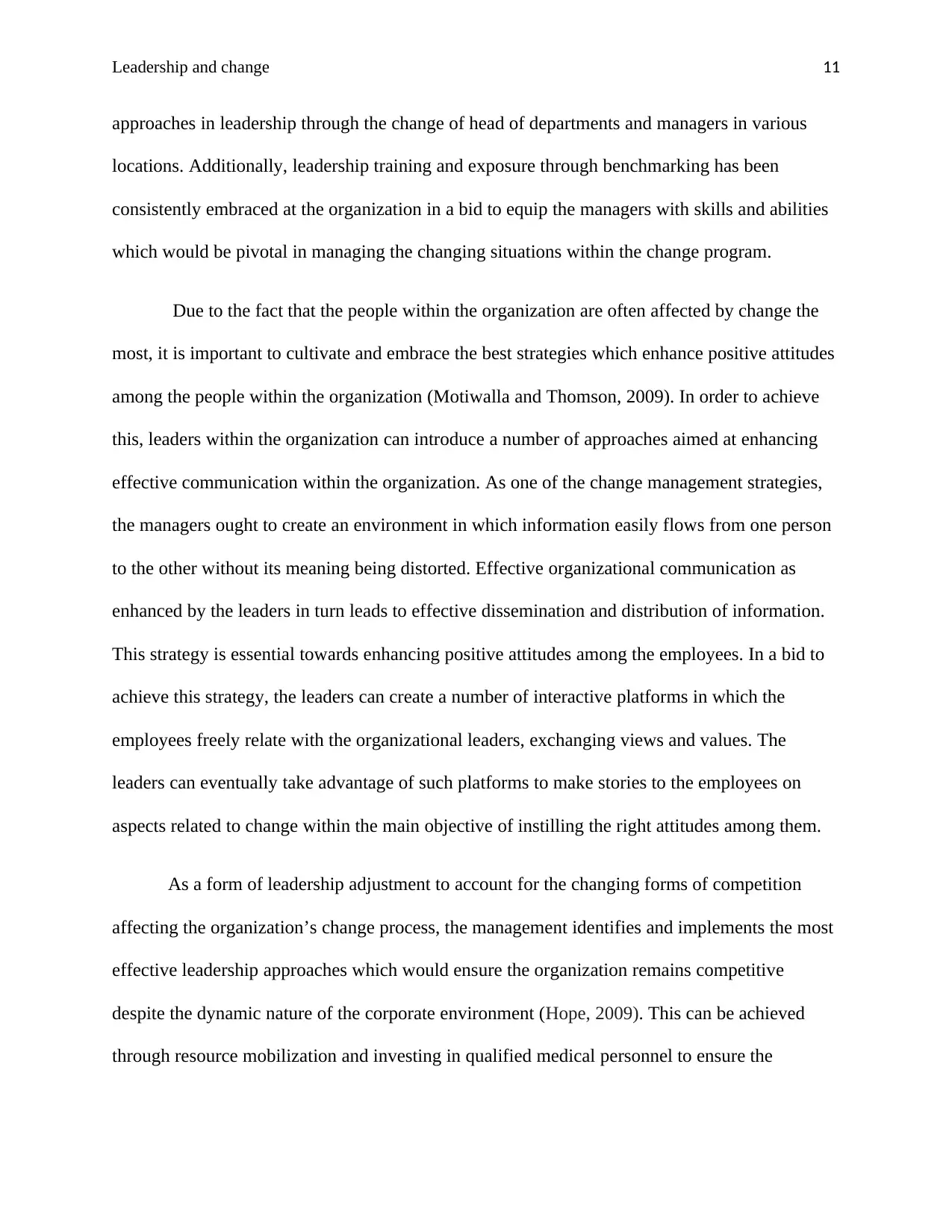
Leadership and change 11
approaches in leadership through the change of head of departments and managers in various
locations. Additionally, leadership training and exposure through benchmarking has been
consistently embraced at the organization in a bid to equip the managers with skills and abilities
which would be pivotal in managing the changing situations within the change program.
Due to the fact that the people within the organization are often affected by change the
most, it is important to cultivate and embrace the best strategies which enhance positive attitudes
among the people within the organization (Motiwalla and Thomson, 2009). In order to achieve
this, leaders within the organization can introduce a number of approaches aimed at enhancing
effective communication within the organization. As one of the change management strategies,
the managers ought to create an environment in which information easily flows from one person
to the other without its meaning being distorted. Effective organizational communication as
enhanced by the leaders in turn leads to effective dissemination and distribution of information.
This strategy is essential towards enhancing positive attitudes among the employees. In a bid to
achieve this strategy, the leaders can create a number of interactive platforms in which the
employees freely relate with the organizational leaders, exchanging views and values. The
leaders can eventually take advantage of such platforms to make stories to the employees on
aspects related to change within the main objective of instilling the right attitudes among them.
As a form of leadership adjustment to account for the changing forms of competition
affecting the organization’s change process, the management identifies and implements the most
effective leadership approaches which would ensure the organization remains competitive
despite the dynamic nature of the corporate environment (Hope, 2009). This can be achieved
through resource mobilization and investing in qualified medical personnel to ensure the
approaches in leadership through the change of head of departments and managers in various
locations. Additionally, leadership training and exposure through benchmarking has been
consistently embraced at the organization in a bid to equip the managers with skills and abilities
which would be pivotal in managing the changing situations within the change program.
Due to the fact that the people within the organization are often affected by change the
most, it is important to cultivate and embrace the best strategies which enhance positive attitudes
among the people within the organization (Motiwalla and Thomson, 2009). In order to achieve
this, leaders within the organization can introduce a number of approaches aimed at enhancing
effective communication within the organization. As one of the change management strategies,
the managers ought to create an environment in which information easily flows from one person
to the other without its meaning being distorted. Effective organizational communication as
enhanced by the leaders in turn leads to effective dissemination and distribution of information.
This strategy is essential towards enhancing positive attitudes among the employees. In a bid to
achieve this strategy, the leaders can create a number of interactive platforms in which the
employees freely relate with the organizational leaders, exchanging views and values. The
leaders can eventually take advantage of such platforms to make stories to the employees on
aspects related to change within the main objective of instilling the right attitudes among them.
As a form of leadership adjustment to account for the changing forms of competition
affecting the organization’s change process, the management identifies and implements the most
effective leadership approaches which would ensure the organization remains competitive
despite the dynamic nature of the corporate environment (Hope, 2009). This can be achieved
through resource mobilization and investing in qualified medical personnel to ensure the
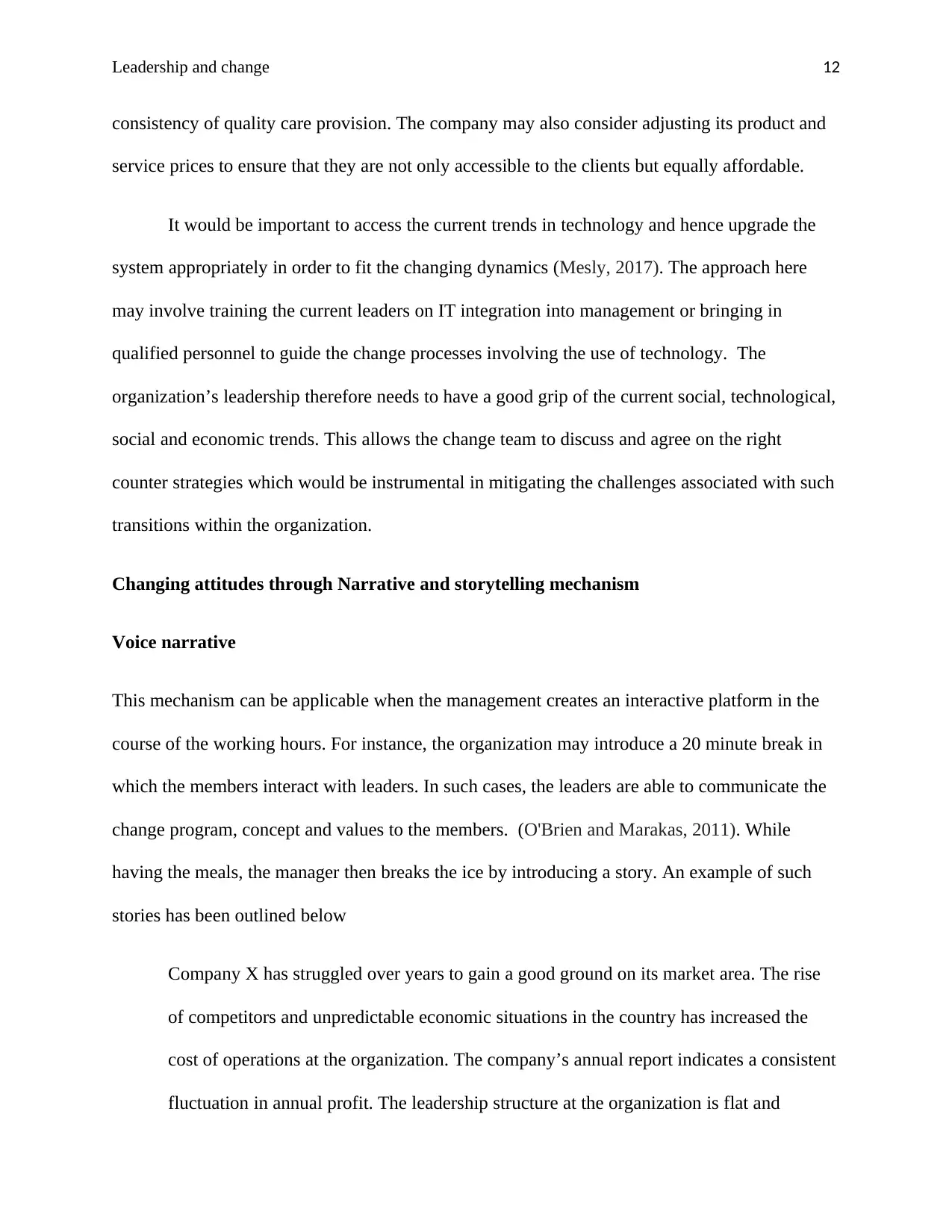
Leadership and change 12
consistency of quality care provision. The company may also consider adjusting its product and
service prices to ensure that they are not only accessible to the clients but equally affordable.
It would be important to access the current trends in technology and hence upgrade the
system appropriately in order to fit the changing dynamics (Mesly, 2017). The approach here
may involve training the current leaders on IT integration into management or bringing in
qualified personnel to guide the change processes involving the use of technology. The
organization’s leadership therefore needs to have a good grip of the current social, technological,
social and economic trends. This allows the change team to discuss and agree on the right
counter strategies which would be instrumental in mitigating the challenges associated with such
transitions within the organization.
Changing attitudes through Narrative and storytelling mechanism
Voice narrative
This mechanism can be applicable when the management creates an interactive platform in the
course of the working hours. For instance, the organization may introduce a 20 minute break in
which the members interact with leaders. In such cases, the leaders are able to communicate the
change program, concept and values to the members. (O'Brien and Marakas, 2011). While
having the meals, the manager then breaks the ice by introducing a story. An example of such
stories has been outlined below
Company X has struggled over years to gain a good ground on its market area. The rise
of competitors and unpredictable economic situations in the country has increased the
cost of operations at the organization. The company’s annual report indicates a consistent
fluctuation in annual profit. The leadership structure at the organization is flat and
consistency of quality care provision. The company may also consider adjusting its product and
service prices to ensure that they are not only accessible to the clients but equally affordable.
It would be important to access the current trends in technology and hence upgrade the
system appropriately in order to fit the changing dynamics (Mesly, 2017). The approach here
may involve training the current leaders on IT integration into management or bringing in
qualified personnel to guide the change processes involving the use of technology. The
organization’s leadership therefore needs to have a good grip of the current social, technological,
social and economic trends. This allows the change team to discuss and agree on the right
counter strategies which would be instrumental in mitigating the challenges associated with such
transitions within the organization.
Changing attitudes through Narrative and storytelling mechanism
Voice narrative
This mechanism can be applicable when the management creates an interactive platform in the
course of the working hours. For instance, the organization may introduce a 20 minute break in
which the members interact with leaders. In such cases, the leaders are able to communicate the
change program, concept and values to the members. (O'Brien and Marakas, 2011). While
having the meals, the manager then breaks the ice by introducing a story. An example of such
stories has been outlined below
Company X has struggled over years to gain a good ground on its market area. The rise
of competitors and unpredictable economic situations in the country has increased the
cost of operations at the organization. The company’s annual report indicates a consistent
fluctuation in annual profit. The leadership structure at the organization is flat and
⊘ This is a preview!⊘
Do you want full access?
Subscribe today to unlock all pages.

Trusted by 1+ million students worldwide
1 out of 16
Related Documents
Your All-in-One AI-Powered Toolkit for Academic Success.
+13062052269
info@desklib.com
Available 24*7 on WhatsApp / Email
![[object Object]](/_next/static/media/star-bottom.7253800d.svg)
Unlock your academic potential
Copyright © 2020–2025 A2Z Services. All Rights Reserved. Developed and managed by ZUCOL.





